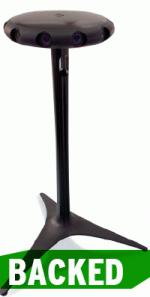
Editor’s note: Ross Rubin is principal analyst at Reticle Research and blogs at Techspressive. Each column will look at crowdfunded products that have either met or missed their funding goals. Follow him on Twitter @rossrubin.
High-quality videoconferencing was once the exclusive province of rich institutions with dedicated high-speed connections. These days, a pair of iPod touches can get you started chatting up your remote friends or colleagues. In February, Starii raised nearly $25,000 to create what would be renamed Swivl, a pan-and-tilt mechanism for iPhones that could track you as you moved. And a follow-up called Galileo, launched in March by Motrr, raised over $700,000 in providing remote access for a similar proposition. But two recent Kickstarter projects take iPhone video interaction to places it has never been before.
Backed: Romotive Romo. Through its extensive use of sensors, your iPhone may know a lot about where it is, but can’t do much to change where it is without being carried there (even though many seem to seek out the back seats of taxis). The Romo robot by Romotive addresses this by imbuing the iPhone with wheels along with a software-developed personality.
Speaking to Kickstarter second-timer Romotive reinforces the point that, at this stage, man seems to be doing at least as much to serve robots as vice versa. For example, citing the power of the Kickstarter community, after raising more than triple its goal for the original Romo, Romotive CEO Keller Rinaudo relays how an early backer of the effort based in Germany offered to upgrade the firmware, which involved disassembling the robot for all of the backers in Europe and return them to their original owners.
Romotive, which had its first Romo robot exceed its funding goal in a manner of days, hopes to avoid such issues with its third-generation set of wheels for iPhones that surpassed its $100,000 funding goal a few weeks ago. In addition to checking in on and playing games with kids of all ages, which it can recognize through cloud-based face tagging, and pets, the new Romo charges faster (a way for it to find its own charger a la iRobot vacuums is being looked into), lasts longer on a charge, tilts the iPhone in order to record and view at a range of angles, and smokes its predecessor in a race. But it’s not all fun and games. Rinuado notes that Romo has applications in fields such as real estate — where it could quickly take photos of many rooms — stringing cable through walls for residential installers, and even going into dangerous environments.
Backed: Altia Systems PanaCast. A basic webcam will do if you’re just looking to see grandma’s face, but the UFO-like PanaCast promises to deliver some alien technology to conference rooms across the world. Project owner Altia has more than doubled its modest $15,000 funding goal with 30 days left in the campaign, giving the impression that the startup is using Kickstarter more for publicity than as a material source of funding.
Using a modern iPhone-class ARM processor to stitch together images from its camera array, the Altia PanaCast is described by Altia as an “ultra-low latency panoramic-HD multi-imager video camera and integrated streaming server.”
The device creates a 200-degree video image but packages it in a standard HD frame for compatibility with existing video software. The benefit of the wide-angle is that it can allow a remote viewer to see more of a conference room, concert, or other environment at once; PanaCast achieves this without the fisheye effect common (and getting somewhat played out in) action cameras such as those from GoPro and Contour.
Indeed, PanaCast technology could be applied to a wide range of uses, including capturing extreme sports. The first-generation product, though, with its stand that makes it look like a miniature Space Needle, seems designed for stationary tasks.
Altia has committed to it selling for less than $700 without any microphones. The company says it thinks customers will want flexibility in choosing the best microphone option for their needs; these could include lavaliers or the one on a Polycom station. It should find an audience with businesses that are looking for dedicated video conferencing but are not ready to step up to something from Logitech-owned LifeSize.
PanaCast optimizes its output for mobile networks; the company has demonstrated its IMAX-like experience running over 3G connections. The iOS apps for remote conference viewing that Altia has developed allow you to slickly pan and zoom in on whoever may be talking, but it would be even slicker if that were automated based on who was talking. That is surely in the queue.



